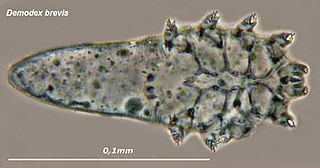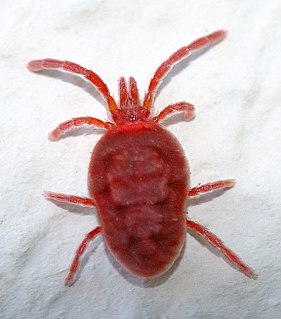
Mange is a type of skin disease caused by parasitic mites. Because mites also infect plants, birds, and reptiles, the term "mange" or colloquially "the mange", suggesting poor condition of the hairy coat due to the infection, is sometimes reserved only for pathological mite-infestation of nonhuman mammals. Thus, mange includes mite-associated skin disease in domestic animals, in livestock, and in wild animals. Since mites belong to the arachnid subclass Acari, another term for mite infestation is acariasis.

Demodicosis, also called demodectic mange or red mange, is caused by a sensitivity to and overpopulation of Demodex spp. as the host's immune system is unable to keep the mites under control.

Blepharitis is one of the most common ocular conditions characterized by inflammation, scaling, reddening, and crusting of the eyelid. This condition may also cause burning, itching, or a grainy sensation when introducing foreign objects or substances to the eye. Although blepharitis is not sight-threatening, it can lead to permanent alterations of the eyelid margin. The overall etiology is a result of bacteria and inflammation from congested meibomian oil glands at the base of each eyelash. Other conditions may give rise to blepharitis, whether they be infectious or noninfectious, including, but not limited to, bacterial infections or allergies.

Rosacea is a long-term skin condition that typically affects the face. It results in redness, pimples, swelling, and small and superficial dilated blood vessels. Often, the nose, cheeks, forehead, and chin are most involved. A red, enlarged nose may occur in severe disease, a condition known as rhinophyma.

An eyelash or simply lash is one of the hairs that grows at the edge of the eyelid. It grows in one layer on the edge of the eyelids. Eyelashes protect the eye from debris, dust and small particles and perform some of the same functions as whiskers do on a cat or a mouse in the sense that they are sensitive to being touched, thus providing a warning that an object is near the eye.

Demodex is a genus of tiny mites that live in or near hair follicles of mammals. Around 65 species of Demodex are known. Two species live on humans: Demodex folliculorum and Demodex brevis, both frequently referred to as eyelash mites, alternatively face mites or skin mites. Different species of animals host different species of Demodex. Demodex canis lives on the domestic dog. The presence of Demodex on mammals is common and usually does not cause any symptoms, although occasionally some skin diseases can be caused by the mites. Demodex is derived from Greek δημός dēmos "fat" and δήξ dēx, "woodworm".

The American Pit Bull Terrier (APBT) is a dog breed recognized by the United Kennel Club (UKC) and the American Dog Breeders Association (ADBA), but not the American Kennel Club (AKC). It is a medium-sized, intelligent, short-haired dog, of a solid build, whose early ancestors came from the British Isles. When compared with the English Staffordshire Bull Terrier, the American Pit Bull Terrier is larger by margins of 6–8 inches (15–20 cm) in height and 25–35 pounds (11–16 kg) in weight. The American Pit Bull Terrier varies in size: males are normally about 18–21 inches (45–53 cm) in height and around 35–60 pounds (15–27 kg) in weight, while females are normally around 17–20 inches (43–50 cm) in height and 30–50 pounds (13–22 kg) in weight.

Demodex folliculorum is a microscopic mite that can only survive on the skin of humans. Most people have D. folliculorum on their skin. Usually, the mites do not cause any harm, and are therefore considered an example of commensalism rather than parasitism. If D. folliculorum does cause disease, this is known as demodicosis.

Steroid-induced rosacea is an iatrogenic condition from the use of either systemic steroid or topical steroids. It is nearly identical to steroid induced acne from the standpoint of etiology.

Lupus miliaris disseminatus faciei , also known as acne agminata, is a disease with a similar appearance to acne vulgaris. The cause of LMDF is unknown.
Demodex mite bite is a cutaneous condition caused by infestation by Demodex folliculorum.

Demodex brevis is one of the two species of face mite that inhabit humans. They are very similar to Demodex folliculorum, with just a few differences. They are usually found in the sebaceous glands of the human body. The same way that D. folliculorum reproduces in the follicles, D. brevis reproduces in the sebaceous glands. Under normal conditions they are not harmful, and are considered to be commensals rather than parasites or symbionts. During a severe infestation, though, there may be adverse effects on the host, such as demodicosis.

The Trombidiformes are a large, diverse order of mites.
Demodex injai is a hair follicle mite in the domestic dog.
Hermann Friedrich Gmeiner (1870–1918) was a physician and first Professor for veterinary internal medicine at the Veterinary Faculty at the University of Giessen (1901–1918). He was succeeded by Friedrich Wilhelm Zwick (1871–1941).
Demodex bovis, also known as the cattle follicle mite, usually causes demodicosis, or demodectic mange, in cattle. This disease is common in tropical areas and is not usually found in temperate environments. Demodicosis is characterized by the formation of papules and nodules over the cattle's skin. These lesions most commonly occur on the neck, shoulders, and armpit of cattle; however, sometimes they also appear on the udder. This condition is often found in cattle with increased stress from pregnancy or lactation. Natural and acquired immunity can cause a decrease in the number of mites infesting a cow, as well as decreasing the severity of a cow's symptoms.
Demodex conicus is a hair follicle mite found in the ear canal of the house mouse, Mus musculus.
Demodex microti is a hair follicle mite from the skin of the genital area of the common vole, Microtus arvalis.
Demodex gatoi is a hair follicle mite from the skin surface of the domestic cat, Felis silvestris. It is the second described species of Demodex from the domestic cat, and is distinguishable from Demodex cati by being shorter and rounder.
Demodex huttereri is a hair follicle mite found in the Meibomian glands of the striped field mouse, Apodemus agrarius.










